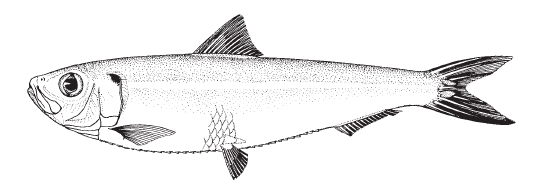Spanish Sardine - Sardinella aurita
*Information from New Jersey Department of Environmental Protection*

Size
Maximum 30 cm standard length, commonly to 25 cm standard length
|
Habitat, biology, and fisheries
Coastal, pelagic, preferring clear salinewater with a minimum temperature of 24 degrees C; from inshore and near surface to edge of continental shelf and down to 350 m (West Africa), or perhaps even deeper. Possible inshore/offshore migration (Florida); off Venezuela, adults live permanently on shelf
and migrate along shelf. Schooling and strongly migratory, often rising to surface at night and dispersing; surface and demersal schools usually associated with upwellings and increased concentrations of zooplankton.
Diurnal migrator. Breeds perhaps at all times of the year, but with distinct peaks; spawning period off Venezuela extending from November to June, chiefly December to April, with peak in January and February; perhaps
mid-June to end of September off North America; September to February in the Gulf of Mexico. Minimum length at sexual maturity about 130mmfork length;sexually mature between ages 2 and 3. Estimated batch fecundity 21 240 to 146 729 eggs (based on females 146 to 188mmfork length). Eggs pelagic, spherical, 1.03 to 1.25 mm. Feeds mainly on zooplankton, especially copepods, but some phytoplankton (especially by juveniles). A foodfish of major commercial importance. Caught throughout the area, but main fishing grounds are off Venezuela (Gulf of Cariaco, Araya Peninsula, and Margarita Island). Total reported catch within the area for 1995 was 154 988 t. Caught with beach seines and purse seines; small quantities are occasionally taken with bottom trawls. Marketed fresh or canned (Venezuela); also widely used as a bait fish.
|
Distribution
Western Atlantic (Cape Cod to Argentina); elsewhere, eastern Atlantic and Mediterranean.
|